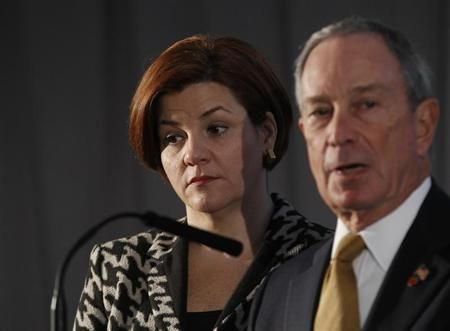NYC Mayor Bloomberg Helps Christine Quinn Win Endorsements From New York Times, Post And Daily News

As the New York City mayoral race heats up, Christine Quinn’s opponents in the crowded Democratic primary have been working overtime to paint the City Council speaker as nothing more than an extension of Mayor Michael Bloomberg, whose 12-year reign comes to an end in November. But those conventional, “more of the same” attacks may only be pushing Quinn closer to the finish line.
Since last week, three of New York’s major daily newspapers have endorsed Quinn as the Democratic choice for mayor. The New York Daily News, the New York Post and the New York Times have all come out in favor of the divisive candidate, whose curt demeanor and reputation for vindictiveness have won her no shortage of sworn enemies bent on keeping her out of Gracie Mansion.
In each of the three Quinn endorsements, the papers stressed the importance of retaining some distinct level of Bloombergness after Bloomberg makes his exit. Relatively speaking, things are good in New York City, the papers remind us, but all that could change on a dime.
It’s clear in reading three similar endorsements from three very different newspapers that the ghost of old New York -- a dangerous amalgam of grimy streets, graffiti-infested subways and open-air drug markets -- still haunts its denizens from all walks of life. New Yorkers may decry today’s soaring rents. They may also lament the demise of the countless mom-and-pop businesses that have been squeezed out in lieu of Starbucks, Forever 21 and big banks. But few would complain about the historically low rates of violent crime that the city has enjoyed for almost two decades.
The Daily News, the first of the papers to endorse Quinn, was quick to point out how precarious the illusion of a perpetually safe New York City really is:
“Like Bloomberg or not, the gains have been real and, because they have been sustained, they are far too easily taken for granted. Allow crime to rise and the party’s over.”
That sentiment was echoed four days later in the Post, though in a far more colorful manner:
“[T]he voters must not be fooled -- we can end up like Detroit faster than you can say David Dinkins. Thugs could take over the streets once again and businesses can pack up for the suburbs. It can happen, and it will happen, unless New Yorkers take this campaign seriously and elect a serious mayor who is ready to tackle serious problems.”
Quinn’s endorsement in the Times offered a more nuanced, if not more ambiguous, characterization of the speaker as an extension of Bloomberg. Touting a long track record of leadership that began during her days as a community advocate, the Times branded Quinn as a “forceful counterpart” to Bloomberg, but one who is not afraid to challenge his missteps:
“Mr. Bloomberg has raised expectations that hard decisions should be made on the merits -- that the city needs a mayor who is willing to say no. More than with the other candidates, that description fits Ms. Quinn.”
None of these endorsements bode well for Quinn’s opponents, in particular Public Advocate Bill de Blasio, who, despite a relatively low profile, had been running neck and neck with Quinn in some polls. In gauging the benefit of three major newspaper endorsements, De Blasio clearly stood to gain the most from the increased visibility. With that moment lost, the race going forward feels like it's Quinn’s to lose.
And as far as predictions go, the Times, in particular, has a pretty good track record as of late. Since 1981, it has endorsed the successful candidate in six of eight mayoral elections.
© Copyright IBTimes 2024. All rights reserved.






















